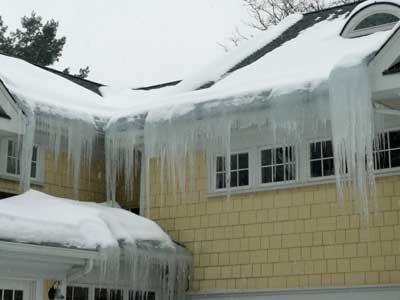
Ice Dams
- Category: Ice Dams
- Written by Dennis Crookshanks
The causes, removal and prevention of roof ice damming.
Ice dams are large areas of ice that build up near the lower edge of your roof when melting snow freezes as it contacts the cold edge of your roof and rain gutter.
The buildup of ice blocks subsequent snow melt from running off the roof and allows water to pool and then leak under your existing shingles and into your house.
Symptoms include, major icicles forming on the gutter, icicles behind the gutter, icicles hanging from the soffit vents, and leaks and stains along the interior and exterior ceiling and walls. Ice dam leaks can also ruin your roof sheathing, rot the gutter board and soffit, and loosen the gutter, shingle, and drip edge fasteners. 
What causes ice dams?
Warming of the snow on a roof when the outside air temperature is below freezing is the cause of the ice dam.
What causes the snow to melt on the roof?
There are many reasons.
From the interior, warm air in the attic can warm the roof sheathing and melt the snow from below. This can be from either insufficient or poorly installed insulation, or air leaking from the interior living space.
Insufficient natural attic ventilation can also contribute to ice dams when warm air that accumulates in the attic is not allowed to readily escape.
From the exterior, warmer temperatures, radiation from the sun and solar radiation reflecting off adjoining building components will cause the snow to melt. There is also heat gain along the gable attic walls and from south and west facing walls.
Are ice dams new?
Ice dams are not new, but they are more prevalent. Before the price of heating fuels began to rise, ice dams were not such a large problem. Heat was cheap and there was not much importance given to keeping the heat in the house. There was little if any insulation in the attic which meant the heat went straight into the attic. The excess heat melted all the snow on the roof and was warm enough to keep the snow melt from re freezing at night. Along with better building methods such as larger roof overhangs, this kept the ice dam leaking to a minimum.
Preventing Ice Dams
Ice dams can often, but not always, be prevented. In many cases either due to economics or climate conditions, they can only be reduced and maintained. For example, a house built with cathedral ceilings with little rafter space for sufficient insulation and venting would require extensive re construction to accommodate these preventive measures.
to be continued...


